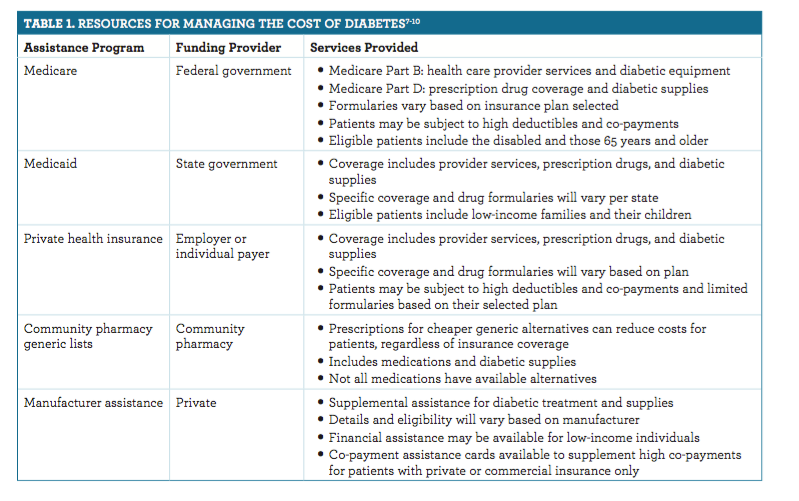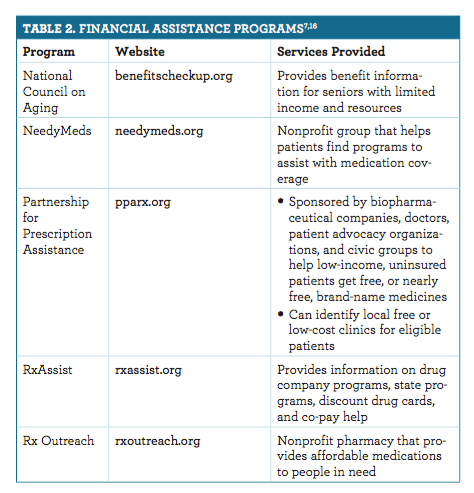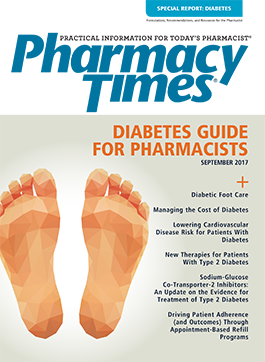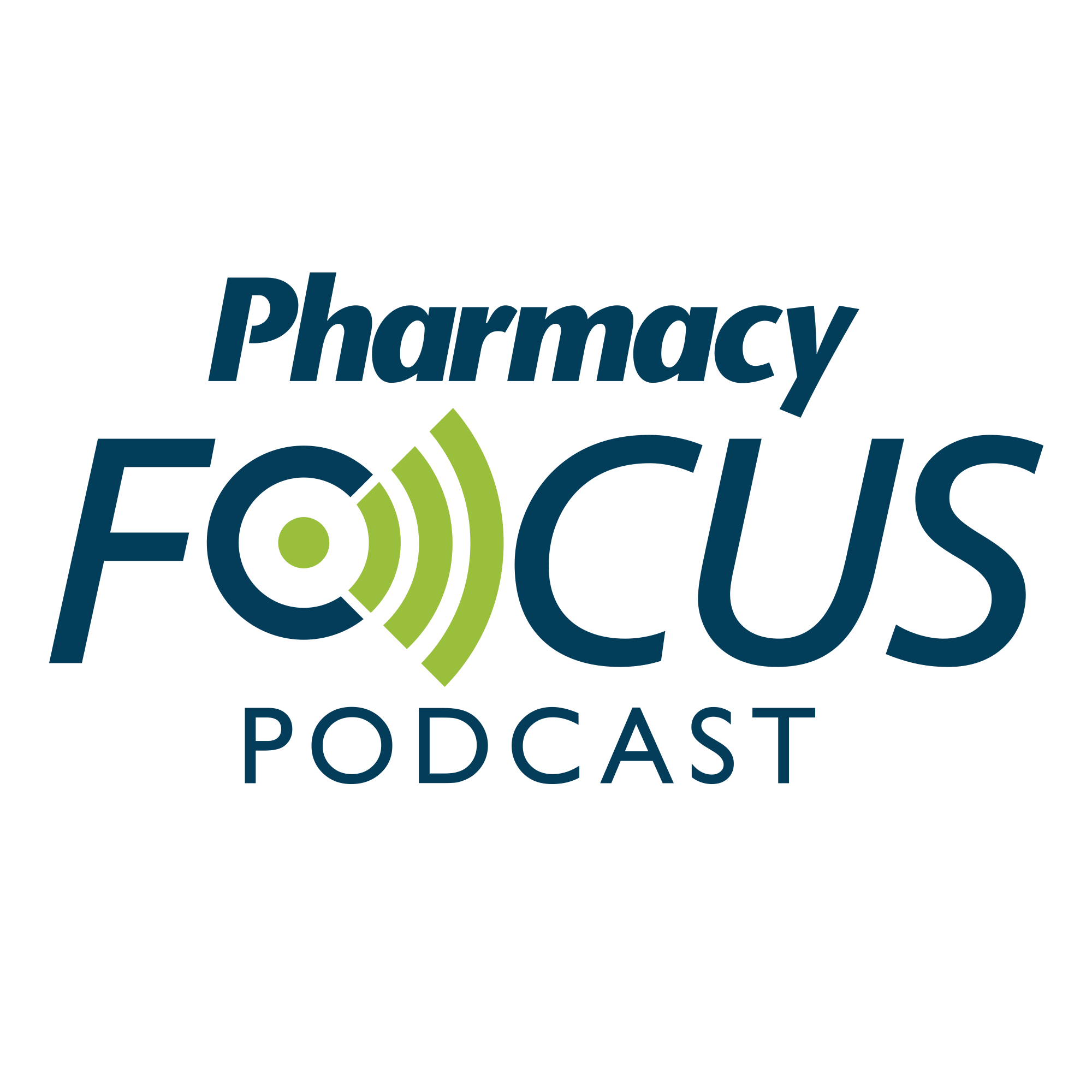Publication
Article
Supplements
Managing the Cost of Diabetes
Author(s):
Diabetes is one of the most common and costly chronic diseases, affecting more than 30 million Americans, with a total annual cost of $245 billion.1
Prevalence continues to increase as obesity rises, with the highest rates of diabetes found in minorities and older Americans. Consequences of diabetes include hypertension, coronary heart disease, stroke, chronic kidney disease, and blindness.2 Despite significant medical advancement in treatment, diabetes remains the seventh leading cause of death in the United States.3 As a result, health care providers must consider the impact of financial and educational barriers in outcomes associated with diabetic management.
Diabetes is associated with a significant financial burden both to the patient and to the health care system. In 2012, the estimated cost of direct med- ical care in diabetes was $176 billion.1 The cost of prescription medications accounted for 18% of that cost, while diabetic supplies accounted for 12%.1
Individuals with diabetes had more than double the cost of annual medical expenditures compared with those without, with an average annual cost of $13,700.1 Although government and private insurance provide patient assistance in managing these costs, financial barriers may still pose a significant obstacle to patients in optimizing diabetic management. Patients who are unable to afford their medications and diabetic supplies will have less than optimal control of their blood sugar and glycated hemoglobin, putting them at increased risk for diabetic complications.
Current guidelines provide detailed stepwise recommendations for initiation and adjustment of oral and injectable glycemic agents. A wide variety of agents are available for management of diabetes. However, agent utilization and medication compliance may depend on a variety of factors, including cost. Diabetic oral and injectable agents and diabetic supplies such as glucose meters, test strips, syringes, and lancets, can have a high cost, which limits patient adherence to therapeutic regimens. Newer agents may be of relatively lower utility based on high cost and moderate glycemic effect.4 The high cost of insulin, which not only is the mainstay therapy for type 1 diabetes but also is required by many patients with type 2 diabetes, further complicates the management of the disease for for individuals with financial barriers.
This is of concern to health care providers because inadequate management of diabetes results in short- and long-term complications. Patients with diabetes and no health insurance have fewer physician visits and are prescribed fewer medications for management of their diabetes. Patients with diabetes make up 11.9% of all emergency department visits in the United States.1 Hispanic and non-Hispanic blacks are at greater risk for developing diabetes and serious associated health complications, including chronic kidney disease.3,5 This may be attributed to a combination of genetics, diet, and exercise. However, access to health care resources may also play an important role.6
For those who qualify, a variety of government and nongovernment programs (table 17-10) can help with covering health care expenses.7 The role of the pharmacist in educating patients about their disease state and therapies to promote compliance, as well as providing valuable resources to assist with financial barriers, can play an important part in optimizing management of diabetes.

Managing the Cost of Diabetes
Medicare
Medicare, a federal health insurance program for patients 65 years and older, can assist with covering the cost of diabetic services, supplies, and equipment. However, patients may be required to meet a deductible or have a co-payment to supplement insurance coverage.7 Medicare Part B provides coverage for health care provider ser- vices and medical equipment, paying for 80% of covered services once a deductible has been met.7 Medicare Part D provides coverage for diabetic medications, including insulin, as well as diabetic supplies such as needles and syringes.7 Patients should be advised that Part D requires separate enrollment and coverage will vary based on whether the plan selected is a health maintenance organization, a preferred provider organization, or a private fee-for-service plan.7 Cost should be considered when choosing a therapeutic agent, as Medicare insurance is not a guarantee of full coverage. Medications may still require a prior authorization for approval or have a high co-payment despite approval.11,12 Additionally, most Medicare plans have a coverage gap, known as the donut hole, in which patients are responsible for higher out-of-pocket expenses once they hit a certain limit for their plan.8,13 Affording diabetic medications and supplies during this coverage gap may be challenging to elderly patients.
Medicaid
Medicaid is a state-run health insurance program for patients with low income. The Children’s Health Insurance Program provides free or low- cost coverage for children whose parents do not qualify for Medicaid but still require assistance with insurance coverage.7 The specific require- ments for enrollment and the services covered, including drug formularies and diabetic supply coverage, may vary from state to state. Patients can enroll at city or county department of social service offices.7 To receive federal funding, all states must provide services, including inpatient and outpatient care, physician visits, and long- term care. Although prescription drug coverage is optional, all states have chosen to include it.9 State insurances may be subject to limited formularies and variable prior-authorization processes.9 Health care providers should refer to insurance-specific formularies and prescribe cheaper alternatives for nonformulary agents.
Private Health Insurance
Private health insurance may be provided through an employer or through individual purchase. Under the Affordable Care Act, patients can no longer be denied coverage for preexisting conditions.7 However, coverage does not guarantee that patients are able to afford their diabetes treatment and care, as they may be subject to high deductibles, co-payments, and limited formularies based on their specific insurance plan.12 If coverage is provided through an employer, patients will lose coverage if they leave their employer unless they elect to pay for the insur- ance on their own through the Consolidated Omnibus Budget Reconciliation Act.7
Supplemental Financial Assistance Programs
Regardless of whether patients qualify as low income, they may require additional assistance with medication coverage to supplement their insurance. To minimize costs, patients can be switched from expensive agents to cheaper alternatives. Many community pharmacies offer a low-cost generic list or program, which can be provided to the patient and the health care provid- er as a reference to guide agent selection. Additionally, diabetic supplies including meters, syringes, and test strips are available as store-brand generics, which can lower cost.10
Manufacturer assistance programs can also supplement the costs of medication and diabetic supplies for eligible patients. These programs are typically available for brand-name agents, and the details of eligibility and assistance will vary based on the manufacturer and the specific program. Drug manufacturers may provide co-payment assistance cards for patients with private or commercial insurance with a high co-payment.7 This can signifi- cantly lower the cost of eligible brand-name prescriptions but is limited to patients with nongovernment insurance.14 Programs targeting low-income individuals will provide assistance with cost once eligibility is determined.15 Eligibility may need to be reevaluated on a recurring basis.
Additional supplemental programs listed in table 27,16 can help patients identify drug assistance programs and determine eligibility based on their medication needs.

The Pharmacist's Role
The cost of diabetic treatment and supplies can affect compliance, placing patients at an increased risk for complications of diabetes. The pharmacist can provide valuable education on the patient’s disease state by emphasizing the importance of medi- cation compliance and nonpharmacologic interventions such as diet and exercise. Pharmacist-conducted patient education and counseling can help prevent the risk of long-term complications, including diabetic nephropathy, chronic kidney disease, and coronary artery disease in patients with diabetes.17 Beyond that, the pharmacist can help patients with identifying financial resources to assist with payment through insurance enrollment and supplemental assistance programs. Additionally, the phar- macist can provide recommendations for cheaper alternatives to therapies that are not covered by insurance or that have high co-payments that are not manageable for the patient.
Conclusion
To improve patient adherence, optimize management of diabetes, and prevent long-term complications, financial barriers must be anticipated and addressed. There are a variety of resources available to supplement costs associated with diabetes treatment and supplies, including government and nongovern- ment insurance and patient assistance programs. The pharmacist can play a valuable role in optimizing diabetes management by educating the patient on the importance of medication compliance and providing information on available resources to address financial concerns.
LARESSA BETHISHOU, PHARMD, BCPS, is an assistant professor of pharmacy practice at Chapman University School of Pharmacy and faculty in residence at Hoag Memorial Hospital Presbyterian, Newport Beach, California.
REFERENCES
1. American Diabetes Association. Economic costs of diabetes in the U.S. in 2012. Diabetes Care. 2013;36(4):1033-1046. doi: 10.2337/dc12-2625.
2. Current burden of diabetes in the U.S. National Institute of Diabetes and Digestive and Kidney Diseases website. niddk.nih.gov/health-information/health-communication-programs/ndep/health-care-professionals/practice-transformation/ why-transform/diabetes-burden/. Accessed August 5, 2017.
3. Statistics about diabetes. American Diabetes Association website. diabetes. org/diabetes-basics/statistics/. Updated July 17, 2017. Accessed August 4, 2017. 4. Pharmacologic approaches to glycemic treatment. American Diabetes Associa- tion. Diabetes Care. 2017;40(suppl 1):S64-S74. doi: 10.2337/dc17-S011.
5. Hispanic health: preventing type 2 diabetes. CDC website. cdc.gov/features/his- panichealth/index.html. Updated September 19, 2016. Accessed August 4, 2017. 6. Spanakis EK, Golden SH. Race/ethnic difference in diabetes and diabetic com- plications. Curr Diab Rep. 2013;13(6):814-823. doi:10.1007/s11892-013-0421-9. 7. Financial help for diabetes care. National Institute of Diabetes and Digestive and Kidney Diseases website. niddk.nih.gov/health-information/diabetes/finan- cial-help-diabetes-care. Accessed August 5, 2017.
8. Costs in the coverage gap. Medicare website. medicare.gov/part-d/costs/cover- age-gap/part-d-coverage-gap.html. Accessed August 8, 2017.
9. Diabetes health coverage: state laws and programs. National Conference of State Legislatures website. ncsl.org/research/health/diabetes-health-coverage- state-laws-and-programs.aspx. Updated January 10, 2016. Accessed August 7, 2017.
10. $4 generic discount drug programs. NeedyMeds website. needymeds.org/ discountdrugprogram.taf?_function=bydrug&drugid=309. Updated February 20, 2017. Accessed August 14, 2017.
11. What’s prior authorization and how does it work? Blue Cross Blue Shield of Michigan website. bcbsm.com/medicare/help/understanding-plans/pharmacy-pre- scription-drugs/prior-authorization.html. Accessed August 14, 2017.
12. Costs for Medicare drug coverage. Medicare website. medicare.gov/part-d/ coverage/part-d-coverage.html. Accessed August 14, 2017.
13. Donut hole, Medicare prescription drug. Healthcare.gov website. healthcare. gov/glossary/donut-hole-medicare-prescription-drug/. Accessed August 14, 2017. 14. Frequently asked questions: insurance. United States Office of Personnel Management website. opm.gov/faqs/topic/insure/. Accessed August 14, 2017. 15. Do you qualify for Rx Outreach? Rx Outreach website. rxoutreach.org/find- out-if-you-are-eligible/. Accessed August 14, 2017.
16. Partnership for Prescription Assistance website. pparx.org/. Accessed August 23, 2017.
17. Palaian S, Chhetri A, Prabhu M, Rajan S, Shankar P. Role of pharmacist in counseling diabetes patients. Internet Scientific Publications website. ispub.com/ IJPHARM/4/1/3272. Accessed August 14, 2017.







